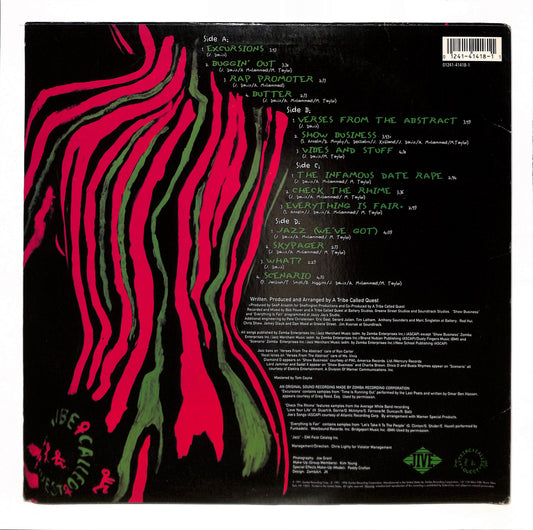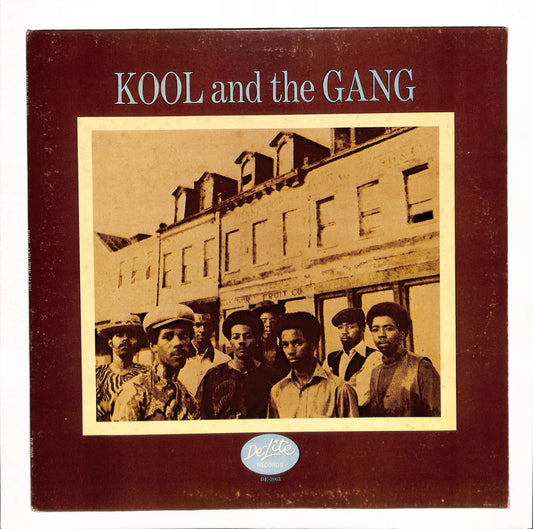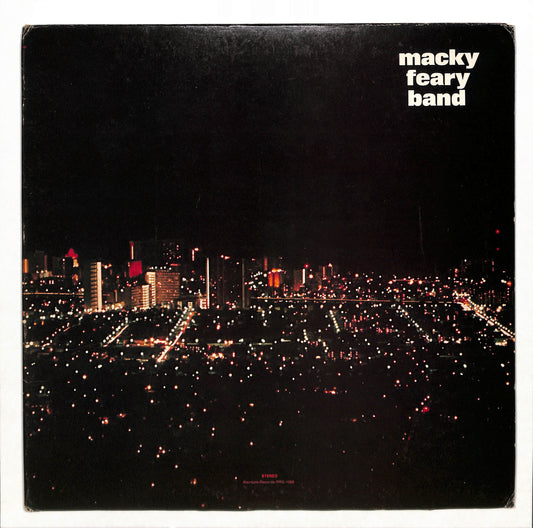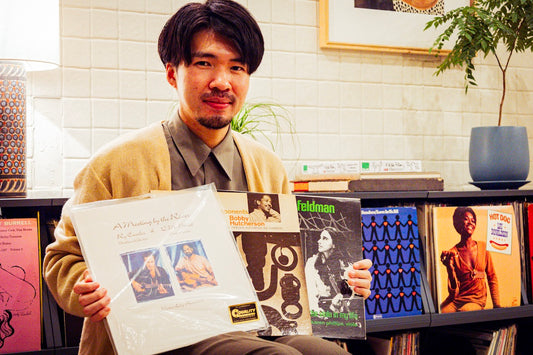"WHAT'S IN YOUR CART?" is an interview series where we invite record-loving guests to choose "5 Records They Want Right Now" from the ELLA ONLINE STORE lineup. For the special first edition, we feature a grand three-part series with three different guests.
Our third guest is MURO, Japan's world-renowned KING OF DIGGIN'. Arriving stylishly at ELLA RECORDS VINTAGE on his motorcycle, he skillfully dug through the record shelves and selected five gems that span genres, from historically significant albums to ultra-rare records. Alongside his passionate talk about the records that have shaped him, MURO also shared more about his journey into the world of vinyl digging.
Interview & text: Mikiya Tanaka (ELLA RECORDS)
Photo: KenKen Ogura (ELLA RECORDS)
Furniture design & production, Interior coordination: "In a Station"
Special thanks to: Satoshi Atsuta
MURO's "5 Records I Want Right Now"
①A Tribe Called Quest / The Low End Theory (1991) US 2xLP reissue
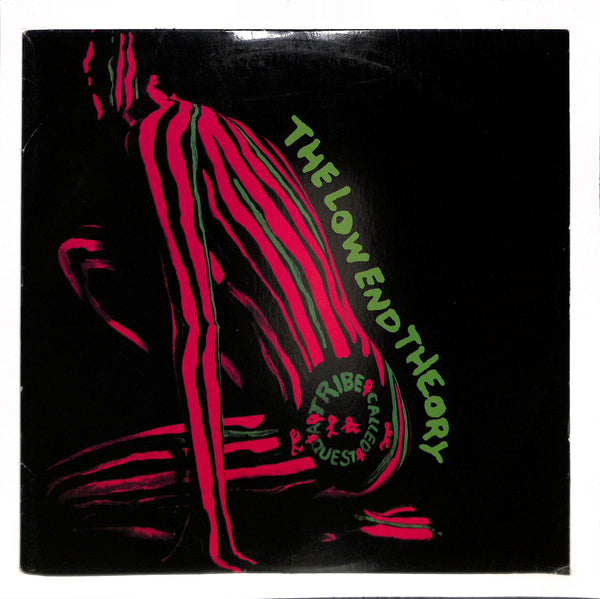
The theme was "5 Records I Want Right Now," but there are just too many that I want lol. So, for this selection, I chose records that have a special meaning to me or ones that I feel like talking about right now. I think I've listened to this second album by A Tribe Called Quest more than any other rap album. It goes beyond the boundaries of hip-hop, sparking my interest in jazz and influencing me in many ways, including the artwork.
During the KRUSH POSSE era, there was a kind of first wave of jazz rap. Gang Starr ended up joining a Japan tour by a Canadian rap group called Dream Warriors. That was the first time KRUSH POSSE was asked to be an opening act, and we did it. KRUSH was already listening to a lot of jazz by then, and digging for records mostly centered around jazz. In that sense, this album was like a textbook for us.
At that time, there were only promo copies of the US version, so I bought the UK version at WAVE. This reissue is a double LP, but the original was a single LP, so the sound level was quite low. I had to work hard to play it in clubs. Nowadays, it's common for albums to be reissued as double LPs or with bonus tracks, and I definitely encourage more of that.
②Kool And The Gang/Kool And The Gang(1969) US
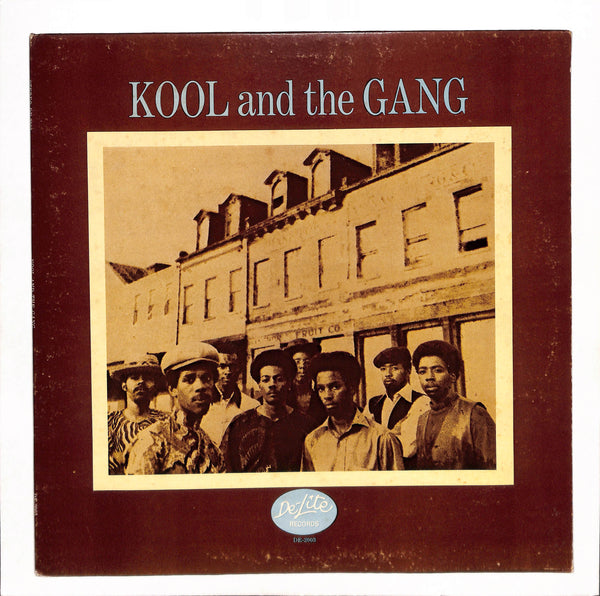
This record was released around the same time I was born. Kool And The Gang has many great records, but this one is particularly outstanding for me. Tracks like B1 "Give It Up" and A3 "Chocolate Buttermilk" are what awakened me to instrumental funk. I also used "Chocolate Buttermilk" as a sample for my track "Hip Hop Band."
It's quite rare to come across an original pressing of this album. When people see this jacket, they probably think of the greatest hits album with the gold cover. At the time, since I couldn't get this album, I bought the greatest hits album and played "Chocolate Buttermilk" and "Give It Up" from that. So, when I finally got my hands on this album, I was really happy. I still remember buying it for a high price at View Records (Soul View), which used to be in front of the triangular police box in Shibuya.
③Macky Feary Band/Macky Feary Band(1978) US original

This was one of the first Hawaiian records I bought, along with Kalapana. I got a Japanese edition with the obi in Jimbocho. It made me realize that there were such amazing tracks in Hawaii as well. The jacket is also really nice, it gives off a home city light vibe. That's how I got into Hawaiian music, but back then, there weren't many places where you could buy Hawaiian records. There was one specialty store in Jimbocho that I used to visit often. Nowadays, I go to Coco-isle in Shibuya or POOL SIDE in Sendagaya.
Later, I was given the opportunity to create a mix called "Hawaiian Breaks" before Hawaii had really come into the spotlight. There were many tracks that were only released on CD, so I included those, and it received a great response. That mix even helped inspire the launch of Aloha Got Soul (a Honolulu-based label and DJ collective focused on Hawaiian rare groove), and it made me really happy to have an impact on people in Hawaii itself.
Hawaiian reggae, and Hawaiian music in general, has a certain gentleness and softness that gives it a unique comfort that no other genre has. This made me fall in love with Hawaii itself, and I started visiting more often. I enjoy treasure hunting there, listening to records on-site. There are many artists who have only released a single 7-inch record, so I believe there's still a lot to discover in Hawaii. Recently, I even have a friend who's been collecting Hawaiian disco records.
④Yasuko Agawa / L.A. Night (1987) Japanese Edition / 12”
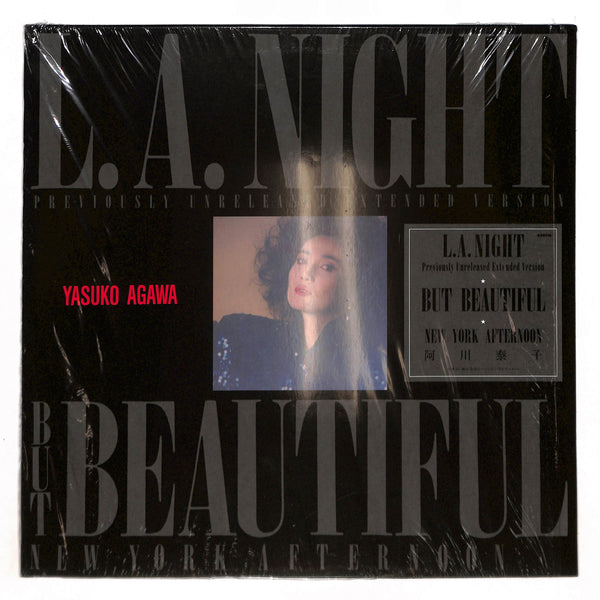
MURO
Oh, this is a clear vinyl! This track represents the beginning of my journey into City Pop records. I think I bought the 12-inch released by the UK label Bluebird at Face Records. I've been paying attention to Japanese fusion since then, with Yasuko Agawa and Kimiko Kasai being my entry points. There aren't many Japanese tracks that can be played alongside international ones, but this one has such high quality that I've been playing it consistently since back then. That's why I was thrilled to finally cut a 7-inch at Tokyo Records in 2018. I still play it often, and young people frequently ask me about it.
By the way, Dimitri From Paris's remix of Asha Puthli's "Space Talk" that came out last year sounds very similar to this track. I think it might be inspired by it.
⑤Dub Specialist/Better Dub (1974)Jamaica original / Silk screen jacket
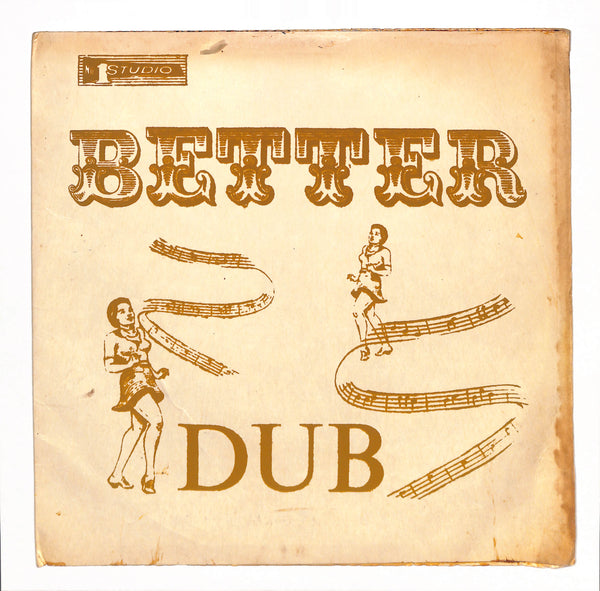
MURO
Among the ones I chose this time, this is the one I truly "want right now." I'm still excited about it lol. I used to collect reggae silk screen jackets for a while, but I've never seen this particular silk screen. The ones I usually see have "BETTER DUB" printed in red and don't have this dancing figure design. The track "Gready G" included in this album has been a rare groove classic for a long time and was sampled by Boogie Down Productions in hip-hop. It was the track that got me to mix reggae into rare groove sets and showed me that there are many cool Jamaican funk tracks, so it holds a special place in my heart.
Interview: MURO and Records

━━Tell us about how you first encountered records.
MURO:When I was a child, my family ran a gas station. I used to play around the yard, playing baseball and such, but it was dangerous when cars came in. So, my mother bought me a portable record player. At that time, there were a lot of books with flexi discs attached, which were like read-along stories for kids. I started collecting those first. Then, I began buying theme songs from cartoons. So, I've been familiar with records since those early days.
When I was in middle school, I wanted to go to discos, but I wasn't old enough to get in. The only music show on TV was "Best Hit USA." However, there was a roller skating rink called "Roller Inn Tokyo" in Itabashi, the neighboring town to Kawaguchi where I lived. A friend's father used to go there and invited me along, and that was the start of everything. They had a DJ booth there and played a lot of soul and funk. Some days they even played electro. There was also a dancer who used to perform with Shingo Kazami practicing breakdancing in the center of the rink. When I asked the DJ about the songs, they would kindly write them down for me. I'd take that paper to a record rental shop, which were becoming popular at the time, borrow the records, and record them onto cassette tapes. That's how it all began.

━━Was that when you first became interested in becoming a DJ?
So, I showcased that at my high school festival, but no one reacted lol. They were like, "What are you doing?" lol. At that time, heavy metal was at its peak, and there weren't any kids doing what I was doing, but I just couldn't get enough of it. I was a quirky kid who hated doing the same things as everyone else. That routine of checking out records at the roller skating rink and then going to the record rental shop continued until the end of high school.

━━How did you first encounter hip-hop?
One day, a school friend who was into heavy metal told me, "There's a guy doing something like you in Harajuku's pedestrian zone," lol. So, I went to check it out and saw DJ KRUSH and others, and I was blown away. I started going there every week. Back then, I was quite noticeable because of my size, so KRUSH approached me and asked if I wanted to help carry records if I liked this kind of music. I said, "Please let me drive." At that time, KRUSH didn't have a driver's license yet, and I had just gotten mine that year. He lived in Oizumi-gakuen and I was in Kawaguchi, so we were pretty close.
I wanted KRUSH to hear my non-stop mixes, so I made tapes every day and picked him up, playing them in the car. It was my biggest joy when KRUSH would ask, "Whose track is this?" That was the best feeling lol. On the other hand, KRUSH taught me about fusion. It was so much fun going record shopping with him in places like Hunter in Ginza, Coconut in Ekoda, and record stores in Ikebukuro like WAVE and the ones in PARCO, which was the closest city to us. Buying fusion records at Hunter was particularly enjoyable. With 2,000 yen, you could buy a solid 20 records. This was around 1989 or 1990.

━━How often do you visit record shops nowadays?
I still go every day. Especially on rainy days, the stores are less crowded, so I can take my time listening to records. My bike even has a roof lol. I can easily get to Shinjuku and Shibuya by bike, and I ride as far west as Kichijoji and as far east as Jimbocho. When I travel to other regions, I always visit local record shops, so I still carry a record map with me.
I've been doing a radio show for the past six years.(TOKYO FM「MURO presents KING OF DIGGIN'」)Each time, there's a theme for the playlist, so I often go looking for records that fit that theme. I also frequently search for sampling sources. I still enjoy spending rainy days listening carefully to records and finding those one or two bars that no one else knows about.

━━How many records do you currently own?
MURO:Well, I've never actually counted, but compared to the past, my collection has significantly decreased. When HMV record shop opened in Shibuya in 2014, I got rid of two rooms' worth of records from my home in Hatagaya where I was living at the time. This coincided with the birth of my child and they offered to help with the move. However, since then, I've probably accumulated another room's worth of records. I sometimes think it's pointless if I just keep buying more lol. When I buy records again for my radio show and see my own markings on them, I think, "Welcome back" lol. It happens quite often. I can't help but wonder what I'm doing lol.
━━How do you manage such a vast record collection?
MURO:I basically organize them by genre, but when I have gigs two or three times a week, they tend to get mixed up. Records I had sorted end up back at my feet. I do have divider boards, but they're not in alphabetical order. I'm curious about how someone like Keiichi Sokabe manages his collection. He has kids and a dog, so his environment is quite similar to mine.
>>> WHAT’S IN YOUR CART? #001 Keiichi Sokabe

━━Do you have a preference for original pressings?
MURO:I still have a preference for original pressings. Even with so many reissues available, I still long for the originals. Especially for albums that hold a special place in my heart, it's not just that I "want" to have the original, but that I "need" to have it. There are some records where I feel, "I'd be embarrassed to play this if it wasn't the original."
━━Do you often buy reissues as well?
MURO:Like the ATCQ album, there are quite a few cases where records are reissued as double LPs or remastered with better sound quality, so I end up buying those as well. Some reissues come with new instrumentals or bonus tracks. I recently bought the anniversary edition of Michael Jackson's album. So, when it comes to records I love, I guess the conclusion is that I buy both the original and the reissue.
Among recent reissues, Cerrone's double LP instrumental collection ("The Classics / Best of Instrumentals," 2021) got me really excited. The nude cover felt like finally seeing the "naked" versions of those classic tracks I admired lol. That emotion is even reflected in the jacket design.

━━Is there a particular genre you are currently searching for or really into right now?
MURO:I just saw an impressive Latin collection on the shelves, and genres like that still have a lot of potential for digging. There aren't many reissues available, and it's not a genre that's been heavily focused on yet. I often go to Disk Union's World (Latin & Brazil) section in Shinjuku as well.
Also, last year I had the opportunity to go to Thailand with Kenji Takimi. During that trip, we visited Maft Sai's home and enjoyed his Asian music collection. It made me realize how vast the Asian music scene still is. He told me that currently, a lot of great Asian records are being found in Turkey, so if I want them, I should go to Turkey.
━━What's at the top of your record want list?
MURO:I guess it's the reggae silk screen records like the ones I chose this time. I'd love to have one in the best condition. Recently, I don't even hear the noise in these kinds of records as noise anymore, which is a bit troubling lol. Since I found "Better Dub" today, it has become my dream record. I've never seen it at Dub Store, nor have I seen it displayed anywhere. My goal now is to get this while I'm still living in Shimokitazawa lol.

━━Has the way you buy and listen to records changed since the advent of subscription services?
MURO:No, it hasn't changed. For me, nothing comes to mind unless I see the jacket. I can't search for things just by text. So, I still need to go to record shops to encounter unknown music and get inspired. It's embarrassing, but it's almost like sleepwalking—before I know it, I'm at some record shop lol.
━━What makes a "good record shop" for you, MURO?
MURO:A good record shop is one where you can't easily leave once you enter lol. I tend to frequent stores where the cheap sections are constantly rotating and the "NEW ARRIVAL" section truly has new arrivals all the time.



